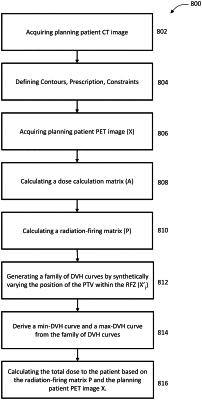| CPC A61N 5/1031 (2013.01) [A61B 6/037 (2013.01); A61B 6/5217 (2013.01); A61N 5/1039 (2013.01); A61N 5/1049 (2013.01); A61N 5/1064 (2013.01); A61N 5/1067 (2013.01); A61N 5/1068 (2013.01); A61N 5/1071 (2013.01); A61N 2005/1034 (2013.01); A61N 5/1036 (2013.01); A61N 5/1037 (2013.01); A61N 5/1038 (2013.01); A61N 5/1045 (2013.01); A61N 2005/1052 (2013.01); A61N 2005/1055 (2013.01); A61N 2005/1058 (2013.01)] | 22 Claims |

|
1. A method for calculating bounded dose-volume histograms (DVH) for evaluating a treatment plan, the method comprising:
generating a plurality of images X′1, 2, 3, . . . j based on an acquired patient image X, where a patient target volume (PTV) is located at j different positions within a radiation-firing zone (RFZ) of a patient;
calculating a dose Dj for each of the images X′1, 2, 3, . . . j by multiplying a dose calculation matrix A with a radiation-firing matrix P and X′j (Dj=A·P·Xj′);
plotting a dose-volume histogram (DVH) curve for each dose Dj to generate a family of j DVH curves, wherein the DVH curve for each dose Dj represents a volume fraction for each dose value; and
generating a minimum boundary curve (min-DVH curve) and a maximum boundary curve (max-DVH curve) of the family of DVH curves, wherein the min-DVH curve comprises a first series of points that represent a minimum volume fraction for each dose value of the family of DVH curves, and the max-DVH curve comprises a second series of points that represent a maximum volume fraction for each dose value.
|